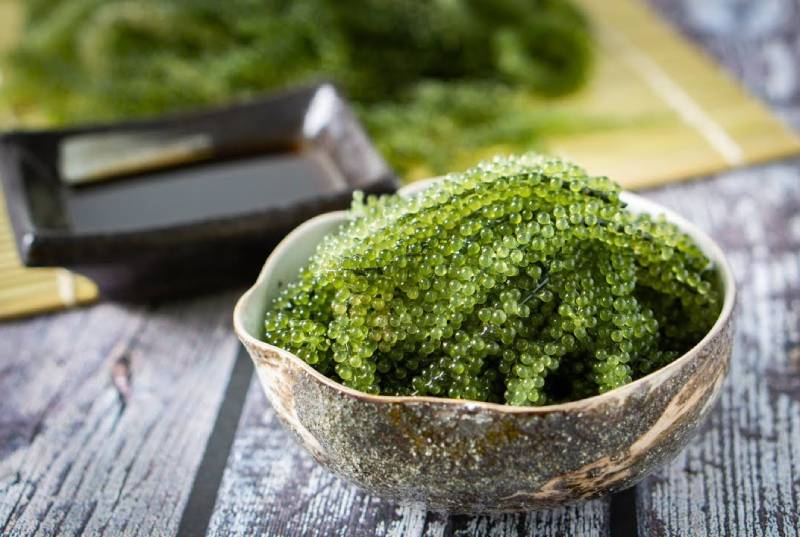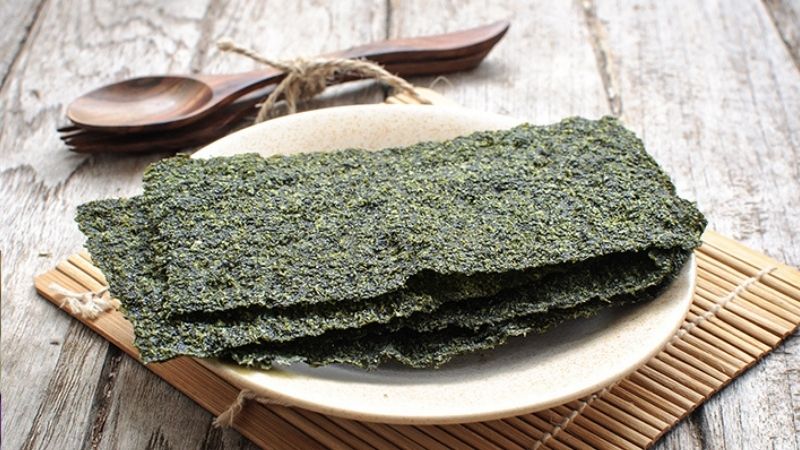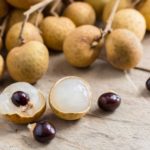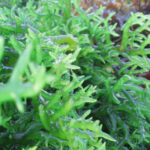Seaweed is an incredibly nutritious food, packed with iodine and other essential nutrients like carbohydrates, protein, and fiber. There are many different types of seaweed, and depending on your needs, some varieties may be more suitable than others.
When it comes to seaweed, one of the most famous dishes is a refreshing and healthy soup with a distinct Korean culinary flavor. Seaweed soup has become a cultural staple in Korea, often served on birthdays. Over time, this culinary tradition has made its way to Vietnam, and now seaweed soup is a familiar dish in both countries. Let’s take a look at some of the best types of seaweed for making this delicious soup!
For further reference:
1. Grapeseed Seaweed
 Grapeseed Seaweed
Grapeseed Seaweed
The coastal region of South Central Vietnam boasts not only picturesque natural scenery and friendly, hospitable locals but also seafood farms integral to the region’s economy. When visiting this area, in addition to indulging in fresh and delectable seafood, be sure to try grapeseed seaweed, considered a precious “sea treasure.”
Grapeseed seaweed is a type of marine algae naturally found in tropical and subtropical regions. Its name derives from its resemblance to a cluster of grapes. This seaweed is a natural food with very high nutritional value and low calories. It is particularly rich in minerals, including vitamins, calcium, and iron, making it highly beneficial for health and supportive in treating various conditions such as detoxification and bowel regulation, normalizing blood sugar levels, lowering cholesterol, and stabilizing blood pressure. Additionally, grapeseed seaweed is considered an effective beauty product for women, promoting healthy skin.
Usage: Cook it in seafood soup, make a sour salad, or pair it with tofu or other vegetables and a dipping sauce for a delicious and appetizing meal.
Drawback: It has a strong fishy smell, so it’s best to combine it with other ingredients to mask the odor.
Reference price: 200,000 VND/kg
2. Kombu Seaweed
 Kombu Seaweed
Kombu Seaweed
Kombu seaweed is predominantly found in the northern waters of Japan. Like other seaweeds, it boasts a high nutritional value, especially in calcium content. Kombu seaweed also nurtures beneficial bacteria, aiding in faster digestion and the elimination of waste from the intestines. As a result, the intestines become cleaner, enhancing the body’s calcium absorption. When naturally sun-dried, a thin layer of white powder forms on the surface, which is incredibly beneficial for health. This powder is not mold but rather the amino acid glutamine.
Advantage: Kombu seaweed has a natural, sweet flavor and is notably free from any fishy odor, making it accessible and enjoyable for everyone. It’s perfect for soups, stews, or cooking with beans and brown rice, as it helps soften the food.
Reference price: 1,200,000 VND/kg (dried Kombu seaweed)
For further reference:
3. Kelp
 Kelp
Kelp
Kelp is a type of seaweed that grows in shallow waters and can be found along coastlines worldwide. When prepared as food, kelp exhibits slight variations in color, taste, and nutritional content. According to nutritionist Vanessa Stasio Costa, kelp is considered a “superfood” due to its abundant mineral content, especially iodine, which is crucial for thyroid function. Additionally, the B-complex vitamins in kelp are essential for cellular metabolism and energy production, while its calcium content contributes to strong bones and healthy muscle function.
Usage: One of the simplest ways to use kelp is to add dried kelp to soups (seaweed soup). You can also use fresh kelp to make salads or dry it and season it with spices.
4. Golden Thread Seaweed
 Golden Thread Seaweed
Golden Thread Seaweed
Golden thread seaweed, also known as golden seaweed, is nutrient-rich and a popular choice due to its appealing flavor. It contains various nutrients, including carbohydrates, fiber, protein, vitamins, and minerals, providing essential trace elements. Golden thread seaweed has blood-boosting properties and is beneficial for the heart, kidneys, nervous system, immune system, circulatory system, and excretory system.
Advantage: It’s a delicious and unique treat, and its versatility allows for multiple cooking methods.
Usage: Soak it in cold water for about 15 minutes to let it expand, then rinse. Use it in salads (mixed with herbs like Vietnamese coriander and red perilla, as well as carrots, and topped with peanuts). It can also be stir-fried, scrambled with eggs, made into a cooling dessert, dried and used in salads, or stir-fried with meat.
Reference price: 400,000 VND/kg
5. Wakame Seaweed
 Wakame Seaweed
Wakame Seaweed
Japanese dried wakame seaweed is renowned for its exceptionally high nutritional value, including calcium, iron, amino acids, and vitamins, as well as a significant amount of fiber. It is recommended for those looking to lose weight, suffering from constipation, or aiming to improve their overall health. Wakame seaweed is an excellent alternative to green vegetables, offering a tasty and nutritious option.
Advantage: Wakame seaweed is easy to use and versatile in cooking. However, avoid soaking it for too long, as it may become mushy and lose its freshness.
Usage: Wakame seaweed is perfect for sushi, rice rolls, seaweed salads, and daily meals, where it can replace green vegetables. It can also be used in soups, salads, and rice rolls.
Reference price: 300,000 VND/kg
For further reference:
Notes on Using Seaweed
 Notes on Using Seaweed
Notes on Using Seaweed
– Choose products that align with your intended use, considering the production date and brand.
– Avoid soaking seaweed for too long, as it may lose its nutritional value.
– Seaweed is rich in iodine, so avoid excessive consumption.
– People with pituitary gland disorders should refrain from consuming seaweed.
For further reference:
Seaweed soup is not only delicious but also highly nutritious. However, it’s essential to consume it in moderation. After reading this article, we hope you can choose the right type of seaweed for your family’s meals.
For more tips and tricks, visit our section.
How to Make Agar Agar Powder Soft and Crispy
Are you curious about the different types of agar powder available on the market? Let us help you in deciding which is best for the delicious agar jelly dessert you love so much. We will explain how to differentiate between different types of agar powder and how to choose one according to your needs.
Seaweed Rice Rolls – Say Goodbye to Torn Nori Sheets with this Simple Tip
Have you ever experienced the frustration of seaweed tearing right in the middle when rolling sushi? It’s a common problem that many sushi chefs and home cooks encounter. But fear not, because I have the solution for you. With my special technique, you will never have to worry about torn seaweed again. Say goodbye to those disappointing sushi rolls and hello to perfectly intact, restaurant-quality sushi every time. So, are you ready to elevate your sushi game and impress your guests with flawless rolls? Let’s dive in and discover the secret to preventing torn seaweed when rolling sushi.






































